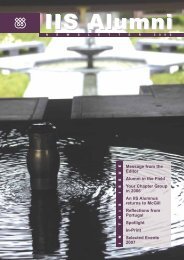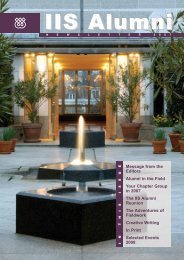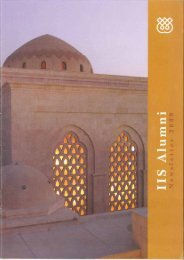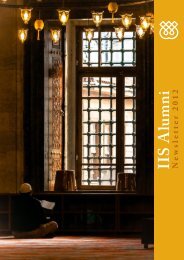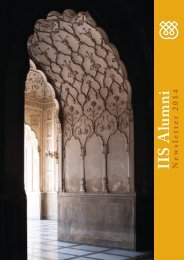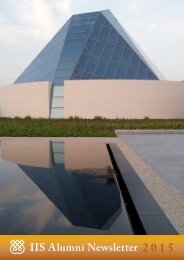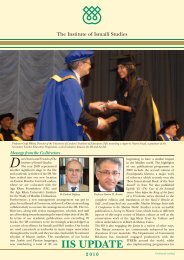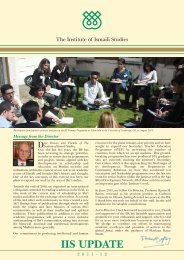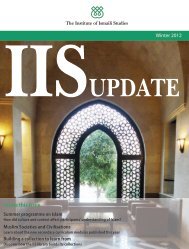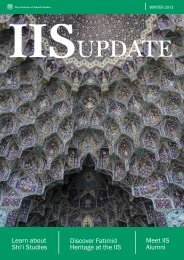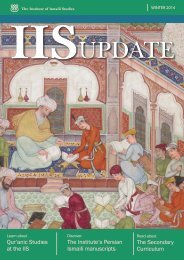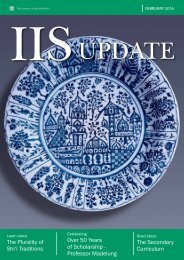Create successful ePaper yourself
Turn your PDF publications into a flip-book with our unique Google optimized e-Paper software.
<strong>Muslim</strong> <strong>Spaces</strong> <strong>of</strong><br />
<strong>Worship</strong> <strong>and</strong> <strong>Gathering</strong>
CONTENT<br />
MUSLIM SPACES OF<br />
WORSHIP AND GATHERING<br />
Introduction<br />
The Mosque / Masjid<br />
Shrines <strong>and</strong> Related <strong>Spaces</strong><br />
The Cemevi<br />
The Jamatkhana<br />
The Mevlevihane <strong>and</strong> Sama‘khana<br />
<strong>Spaces</strong> <strong>of</strong> Personal Retreat<br />
Further Reading<br />
05<br />
11<br />
43<br />
61<br />
65<br />
79<br />
93<br />
101
Geometric Pattern:<br />
A photograph <strong>of</strong> the geometric pattern that adorns<br />
the interior <strong>of</strong> the Ismaili Centre Burnaby. In Islamic art<br />
geometric patterns represent the symbol <strong>of</strong> unity <strong>and</strong> the<br />
ultimate source <strong>of</strong> all diversity in creation.<br />
Photo credit: Asif Lakhani.<br />
Overleaf:<br />
Glass crystalline dome descending to a white onyx<br />
translucent block. In designing the Ismaili Centre,<br />
Toronto, Charles Correa’s vision was to create a building<br />
that responds to the traditions <strong>of</strong> Islamic architecture in a<br />
contemporary design using modern materials.<br />
Photo credit: Gary Otte.<br />
INTRODUCTION
The historical formation <strong>of</strong> <strong>Muslim</strong> societies has resulted<br />
in diverse communities <strong>of</strong> interpretation, reflecting a rich<br />
intellectual, cultural, spiritual <strong>and</strong> institutional pluralism.<br />
This diversity is invariably reflected in the formation <strong>of</strong><br />
<strong>Muslim</strong> spaces <strong>of</strong> worship <strong>and</strong> gathering throughout<br />
history, <strong>and</strong> continues today.<br />
This short introduction to <strong>Muslim</strong> spaces <strong>of</strong> worship <strong>and</strong><br />
gathering showcases aspects <strong>of</strong> the richness <strong>and</strong> diversity<br />
<strong>of</strong> the worldwide <strong>Muslim</strong> community (Umma) through<br />
the variety <strong>of</strong> spaces used for expressions <strong>of</strong> piety <strong>and</strong><br />
community gathering.<br />
6 7
For many centuries, a prominent feature <strong>of</strong> the<br />
<strong>Muslim</strong> religious l<strong>and</strong>scape has been the variety <strong>of</strong><br />
spaces <strong>of</strong> gathering co-existing harmoniously with<br />
the masjid, which in itself has accommodated a<br />
range <strong>of</strong> diverse institutional spaces for educational,<br />
social <strong>and</strong> reflective purposes. Historically serving<br />
communities <strong>of</strong> different interpretations <strong>and</strong> spiritual<br />
affiliations, these spaces have retained their cultural<br />
nomenclatures <strong>and</strong> characteristics, from ribat <strong>and</strong><br />
zawiyya to khanaqa <strong>and</strong> jamatkhana.<br />
His Highness the Aga Khan at Foundation Ceremony,<br />
Dubai Ismaili Centre, 13 December, 2003<br />
8 9
THE MOSQUE / MASJID
Baadshahi Mosque<br />
Photo Credit: Credit: Guilhem Vellut, Creative Commons.<br />
The Mosque / Masjid<br />
The mosque/masjid is the most prominent<br />
congregational space in the <strong>Muslim</strong> world,<br />
however, little attention has been given to<br />
its varied types <strong>and</strong> uses amongst <strong>Muslim</strong><br />
determine the nature <strong>of</strong> the rituals that take<br />
place in a mosque <strong>and</strong> the considerations<br />
to whether or not a mosque accommodates<br />
one gender or both.<br />
communities.<br />
The word jami‘ refers to a place <strong>of</strong> communal<br />
The English word ‘mosque’ refers, in<br />
actuality, to a series <strong>of</strong> words used in the<br />
languages spoken in the <strong>Muslim</strong> world. The<br />
most common <strong>of</strong> these is masjid, a word <strong>of</strong><br />
Arabic origin, signifying a place where one<br />
prostrates. In old Semitic languages such as<br />
Aramaic, Nabatean, Syriac <strong>and</strong> Amharic, a<br />
masjid refers to a place <strong>of</strong> worship <strong>of</strong> other<br />
gathering, <strong>and</strong> is distinguished from a masjid<br />
in that it accommodates large numbers <strong>of</strong><br />
congregants for the weekly Friday mid-day<br />
prayer. In Indonesia, jami‘ is referred to<br />
as masjid agung (great mosque), which is<br />
usually a larger space than jami‘. The term<br />
also signifies the ‘royal’ or ‘principal’ mosque<br />
in a town or city.<br />
religions as well. Over time, the word came<br />
to be specifically referenced, in the <strong>Muslim</strong><br />
tradition, to the principal <strong>Muslim</strong> space for<br />
gatherings <strong>and</strong> <strong>of</strong>fering prayers.<br />
Buildings dedicated as musallas, namazgahs<br />
or namaz-khanas are usually informal spaces<br />
used by <strong>Muslim</strong>s for private or small group<br />
prayers <strong>and</strong> can <strong>of</strong>ten be found in public places<br />
The regional <strong>and</strong> historical developments <strong>of</strong><br />
the types <strong>of</strong> mosques, including the variety<br />
<strong>of</strong> architectural features, is influenced by<br />
a number <strong>of</strong> factors ranging from culture,<br />
such as train <strong>and</strong> bus stations. In parts <strong>of</strong> the<br />
Arab world, a musalla can also designate a<br />
large space, usually on the outskirts <strong>of</strong> a city,<br />
used twice yearly for the ‘Id or festival prayers.<br />
language, politics <strong>and</strong> the forms <strong>and</strong> The term ‘Id-gah is used more commonly for<br />
expressions <strong>of</strong> piety. These factors also such spaces amongst South Asian <strong>Muslim</strong>s.<br />
12 13
The Mosque <strong>of</strong> The Prophet<br />
al-Masjid al-Nabawi<br />
al-Madina al-Munawwara, Saudi Arabia<br />
Built in 622 CE by the <strong>Muslim</strong> community<br />
in Yathrib, later called al-Madina al-<br />
Munawwara, the mosque <strong>of</strong> the Prophet<br />
was situated next to the Prophet’s house.<br />
It was essentially a square enclosure, built<br />
with palm trunks <strong>and</strong> mud walls <strong>and</strong> was<br />
accessed through three doors, Bab al-<br />
Rahma, Bab Jibril <strong>and</strong> Bab al-Nisa’. Within<br />
this enclosure, there was a shaded area to<br />
the south called the suffrah, which aligned<br />
the prayer space facing north, towards<br />
Jerusalem. Later on, the Prophet changed<br />
the direction <strong>of</strong> this space (qibla) to the<br />
south – facing masjid al-Haram or the<br />
Ka’ba, in the city <strong>of</strong> Mecca. Seven years<br />
later, the mosque was doubled in size, to<br />
accommodate the increasing number <strong>of</strong><br />
<strong>Muslim</strong>s.<br />
Floor plan <strong>of</strong> al-masjid al-Nabawi as it may<br />
have looked in the time <strong>of</strong> the Prophet.<br />
Credit: Keith Turner (Draftsman), MIT Libraries,<br />
Aga Khan Documentation Centre.<br />
Read more about al-Masjid al-Nabawi<br />
Courtyard <strong>of</strong> al-Masjid al-Nabawi.<br />
Credit: Adzril, Creative Commons.<br />
14<br />
15
A contemporary view <strong>of</strong> al-masjid al-Nabawi.<br />
Credit: Elias Pirasteh, Creative Commons.<br />
16<br />
17
The Great Umayyad Mosque<br />
al-Jami‘ al-Umawi al-Kabir<br />
Damascus, Syria<br />
The Great Umayyad Mosque in the old city<br />
<strong>of</strong> Damascus, is the first monumental work<br />
<strong>of</strong> architecture in the <strong>Muslim</strong> history. The<br />
mosque is situated on the site <strong>of</strong> a Christian<br />
basilica dedicated to St John the Baptist,<br />
the Prophet Yahya, who is a figure <strong>of</strong><br />
reverence to both Christians <strong>and</strong> <strong>Muslim</strong>s.<br />
From 661 CE, during the reign <strong>of</strong> the first<br />
Umayyad caliph Mu‘awiya, <strong>Muslim</strong>s shared<br />
the church with the Christians. They prayed<br />
in the eastern section <strong>of</strong> the ancient temple<br />
whilst the Christians prayed in the western<br />
side.<br />
This collective use continued until the reign<br />
<strong>of</strong> the fifth Ummayad caliph, al-Walid bin<br />
Abdul Malik (d. 705 CE), when the prayer<br />
space became inadequate. The caliph<br />
negotiated takeover <strong>of</strong> the whole space by<br />
the <strong>Muslim</strong>s, promising safety to all other<br />
churches around the city <strong>and</strong> the addition <strong>of</strong><br />
a new church which would be dedicated to<br />
the Virgin, for Christians as compensation,<br />
in return.<br />
Read more about Jami‘ al-Umawi al-Kabir<br />
TOP IMAGE: The Great Mosque<br />
<strong>of</strong> the Umayyads in Damascus.<br />
Credit: Dan, Creative Commons.<br />
18<br />
Qibla, prayer direction, <strong>and</strong> minbar, platform for issuing<br />
sermons at the Great Mosque <strong>of</strong> Damascus.<br />
Credit: Russell Harris, The Institute <strong>of</strong> Ismaili Studies.<br />
Shrine housing the head <strong>of</strong> Prophet Yahya (St John the Baptist)<br />
situated inside the Mosque space.<br />
Credit: Russell Harris, The Institute <strong>of</strong> Ismaili Studies.<br />
19
The Great Mosque <strong>of</strong> Mahdiyya<br />
Mahdiyya, Tunisia<br />
The Great Mosque <strong>of</strong> Al Azhar<br />
Cairo, Egypt<br />
Al-Jami‘ al-Kabir, the Great Mosque, <strong>of</strong> Mahdiyya was originally built in 916 CE by the<br />
first Fatimid Imam-Caliph, Abd Allah al-Mahdi, the founder <strong>of</strong> the Fatimid dynasty.<br />
Established in 909 CE as a Shi‘i caliphate in north Africa, the Fatimids posed a direct<br />
challenge to the Abbasid caliphate, who ruled from Baghdad, <strong>and</strong> the Umayyads <strong>of</strong><br />
al-Andalus ruling from Cordoba, Spain. Mahdiyya, in present-day Tunisia, was capital<br />
city founded by the Fatimids.<br />
Watch a video clip <strong>of</strong> The Great Mosque <strong>of</strong> Mahdiyya; Read more about The Great<br />
Mosque <strong>of</strong> Mahdiyya<br />
In 973 CE, during the reign <strong>of</strong> fourth Fatimid<br />
imam-caliph al-Mu‘izz, the caliphal seat<br />
was transferred to the newly founded city<br />
<strong>of</strong> Cairo, Egypt. Al-Azhar mosque was built<br />
in Cairo <strong>and</strong> the first khutba, sermon, was<br />
delivered from its pulpit, minbar, in 972<br />
CE. From that time until today al-Azhar<br />
has continued to serve as a distinguished<br />
<strong>Muslim</strong> educational institution.<br />
Other well-known surviving mosqueuniversities<br />
from the early period <strong>of</strong> Islam<br />
are Jami‘ al-Qarawiyyin in Fez, Morocco<br />
<strong>and</strong> Jami‘ al-Zaytuna, in Tunis, Tunisia.<br />
Read more about The Great Mosque <strong>of</strong> al-<br />
Azhar<br />
Read about Fatimid Cairo as described by<br />
Nasir-i Khusraw, an eleventh-century CE<br />
Isma‘ili da‘i, philosopher <strong>and</strong> poet<br />
20<br />
The surviving Fatimid portal <strong>of</strong> the Great Mosque <strong>of</strong> Mahdiyya.<br />
Credit: Shiraz Kabani, The Institute <strong>of</strong> Ismaili Studies.<br />
Contemporary view <strong>of</strong> al-Azhar Mosque.<br />
Credit: Nasser Rabat, MIT Libraries, Aga Khan Visual Archive.<br />
21
The Great Mosque <strong>of</strong> Huajuexiang<br />
Xian, China<br />
The Great Mosque <strong>of</strong> Huajuexiang is the largest <strong>and</strong> best preserved <strong>of</strong> the early<br />
mosques <strong>of</strong> China. Built in fifteenth century CE, during the reign <strong>of</strong> the Ming Dynasty.<br />
The mosque is a great example <strong>of</strong> the use <strong>of</strong> Chinese architectural elements in mosque<br />
architecture.<br />
Read more about Huajuexiang Mosque<br />
TOP IMAGE<br />
A view <strong>of</strong> the courtyard <strong>of</strong> the mosque.<br />
Credit: Preston Rhea, Creative Commons.<br />
BOTTOM IMAGE<br />
Interior view <strong>of</strong> the Mosque.<br />
Credit: Rizwan Mawani, The Institute <strong>of</strong><br />
Ismaili Studies.<br />
Entrance to the Great Mosque <strong>of</strong> Huajuexiang.<br />
Credit: Mararie, Creative Commons.<br />
22 23
Masjid-i Imam<br />
Isfahan, Iran<br />
Masjid-i Imam, formerly known as Masjid-i Shah, was commissioned in the early 17 th<br />
century by Safavid Shah Abbas. The mosque was constructed on the south side <strong>of</strong><br />
Isfahan’s royal square, the maydan.<br />
Read more about Masjid-i Imam<br />
General View <strong>of</strong> Masjid-i Imam.<br />
Credit: Daniel C. Waugh Archive, Aga Khan Documentation Centre at MIT.<br />
The Portal <strong>of</strong> Masjid-i Imam.<br />
Credit: Daniel C. Waugh Archive,<br />
Aga Khan Documentation Centre at MIT.<br />
24 25
Badshahi Masjid<br />
Lahore, Pakistan<br />
Considered one <strong>of</strong> the last great monuments<br />
<strong>of</strong> the Mughal period, the mosque remains<br />
the largest on the Indian subcontinent. It is<br />
adjacent to the western wall <strong>of</strong> the Lahore<br />
Fort, <strong>and</strong> was commissioned by the Emperor<br />
Awrangzeb (1658-1707) to house a number<br />
<strong>of</strong> relics <strong>of</strong> the Prophet.<br />
Read more about the Badshahi Masjid<br />
Interior view <strong>of</strong> the arcade in Badshahi Masjid.<br />
Credit: Guilhem Vellut, Creative Commons.<br />
TOP IMAGE<br />
Exterior View <strong>of</strong> the Badshahi Masjid.<br />
Credit: Guilhem Vellut, Creative Commons.<br />
BOTTOM IMAGE<br />
Sunset at the Badshahi Masjid.<br />
Credit: Matthieu Paley,<br />
Aga Khan Development Network.<br />
26 27
A view <strong>of</strong> the courtyard <strong>of</strong><br />
The Great Mosque <strong>of</strong> Herat.<br />
© Aga Khan Trust for Culture.<br />
The Great Mosque <strong>of</strong> Herat<br />
Herat, Afghanistan<br />
The Great Mosque <strong>of</strong> Herat is the city’s first congregational mosque. It was built on<br />
the site <strong>of</strong> two smaller Ghaznavid mosques that were destroyed by an earthquake<br />
<strong>and</strong> a fire. The present mosque survives from Gurid times (1011–1215 CE).<br />
Read more about the Great Mosque <strong>of</strong> Herat<br />
A Kart period (791–1389 CE) cauldron in mosque courtyard.<br />
Credit: Archnet.org. Reproduced with permission <strong>of</strong> the Fine Arts Library <strong>of</strong> the Harvard College Library.<br />
28 29
Ulu Camii ve Darüşşifası<br />
Divriği, Turkey<br />
The Ulu Camii ve Darüşşifası is the oldest<br />
<strong>and</strong> most elaborately decorated medieval<br />
monument in Anatolia. The mosque<br />
was built in 1229 CE by the Mengujukid<br />
emir Ahmet Shah, <strong>and</strong> the hospital was<br />
commissioned by his wife Melike Turhan<br />
Melek.<br />
The Ulu Camii ve Darüşşifası, are well<br />
preserved <strong>and</strong> have a storied history,<br />
including use during World War II as the<br />
secret vault for the treasures <strong>of</strong> the Topkapi<br />
Palace.<br />
Read more about Divigri Ulu Camii ve<br />
Darüşşifası<br />
Decorative detail on the portal.<br />
Credit: University <strong>of</strong> Hawaii Museum.<br />
A view <strong>of</strong> Ulu Camii ve Darüşşifası in the surrounding urban setting <strong>of</strong> Divriği.<br />
Credit: University <strong>of</strong> Hawaii Museum.<br />
30 31
‘Idgah Kashghar<br />
Xingjiang, China<br />
University Mosque<br />
Depok, Indonesia<br />
Incorporating older structures dating back to late 10th century CE, the ‘Idgah was<br />
built by the ruler <strong>of</strong> Kashgar, Saqsiz Mirza, in the mid-15th century CE.<br />
Read more about ‘Idgah Kashghar<br />
The basic design concept <strong>of</strong> this<br />
contemporary mosque, built in 1990, is<br />
derived from the general type <strong>of</strong> masjids in<br />
Indonesia that are characterised by multitiered<br />
ro<strong>of</strong>.<br />
Read more about the University Mosque <strong>of</strong><br />
Depok<br />
A view to the main staircase <strong>of</strong> the mosque.<br />
Credit: Courtesy <strong>of</strong> the project architect,<br />
Aga Khan Award for Architecture.<br />
General view <strong>of</strong> ‘Idgah Kashghar.<br />
© The Institute <strong>of</strong> Ismaili Studies.<br />
General view <strong>of</strong> the mosque.<br />
Credit: Courtesy <strong>of</strong> the project architect,<br />
Aga Khan Award for Architecture.<br />
View <strong>of</strong> the mosque’s main gate.<br />
Credit: Courtesy <strong>of</strong> the project architect,<br />
Aga Khan Award for Architecture.<br />
32 33
Gr<strong>and</strong> National Assembly Mosque<br />
Ankara, Turkey<br />
A distinguished architectural feature <strong>of</strong> the<br />
National Assembly mosque is the qibla wall<br />
that opens onto the terraced garden. The<br />
arrangement <strong>of</strong> the qibla wall <strong>and</strong> the mihrab<br />
in glass is rather unconventional. With a<br />
view to the l<strong>and</strong>scaped gardens, the act <strong>of</strong><br />
prayer becomes completely transformed<br />
by bringing the worshipers physically closer<br />
to nature. By the means <strong>of</strong> such design<br />
features the mosque acknowledges its<br />
environment, thereby enhancing the acts<br />
<strong>of</strong> prayer <strong>and</strong> devotion that are essential to<br />
Islam. The mosque received the Aga Khan<br />
Award for Architecture in 1995.<br />
Read more about the Gr<strong>and</strong> National<br />
Assembly Mosque<br />
The glass qibla wall overlooking a l<strong>and</strong>scaped garden.<br />
Credit: Reha Günay, Aga Khan Award for Architecture.<br />
The Gr<strong>and</strong> National Assembly Mosque amidst the Parliament buildings in the background.<br />
Credit: Reha Günay, Aga Khan Award for Architecture.<br />
34 35
Tengku Tengah Zaharah Mosque<br />
Tanjung Bungah, Malaysia<br />
Cologne Islamic Cultural Centre<br />
Cologne, Germany<br />
The Tengku Tengah Zaharah mosque, also known as Floating Mosque, is a free-st<strong>and</strong>ing<br />
white sculptural form. Sitting against the backdrop <strong>of</strong> the vast South China Sea, the<br />
mosque is built on an open s<strong>and</strong>y area with water flowing under it.<br />
The centre is considered a prototype for the<br />
co-existence <strong>of</strong> <strong>Muslim</strong>s <strong>and</strong> non-<strong>Muslim</strong>s<br />
in Germany. The main elements <strong>of</strong> the<br />
centre are grouped around a raised public<br />
plaza, accessed by a wide staircase. At the<br />
street level, there is bazaar <strong>and</strong> a conference<br />
room. The library, <strong>of</strong>fices <strong>and</strong> museum<br />
frame two sides <strong>of</strong> the plaza <strong>and</strong> reflect the<br />
existing urban fabric in height <strong>and</strong> massing.<br />
The domed prayer hall dominates the third<br />
side. Over 70% <strong>of</strong> the energy needed for<br />
heating <strong>and</strong> cooling is derived from the onsite<br />
geothermal resources.<br />
Read more about Cologne Islamic Cultural<br />
Centre<br />
General view to Tengku Tengah Zaharah Mosque.<br />
Credit: Bahrin Shah Raja, Aga Khan Award for Architecture.<br />
TOP IMAGE:<br />
Aerial view <strong>of</strong> the Cologne Islamic Cultural Centre.<br />
Credit: Architecturbüro Paul Böhm,<br />
Aga Khan Award for Architecture.<br />
BOTTOM IMAGE:<br />
Ground level view <strong>of</strong> the Cologne Islamic Cultural Centre.<br />
Credit: Bjarke Liboriussen, Creative Commons.<br />
36 37
COMMUNITY SPECIFIC MOSQUES<br />
al-Kazimiya<br />
Baghdad, Iraq<br />
General view <strong>of</strong> al-Kazimiya.<br />
Credit: Historical Atlas <strong>of</strong> the Islamic<br />
World (2004).<br />
The shrine <strong>of</strong> al-Kazimiya is located near Baghdad. It is a major pilgrimage site for<br />
the Twelver Shi‘a, Ithna‘ashari, communities. The shrine hosts the tombs <strong>of</strong> imams<br />
Musa al-Kazim <strong>and</strong> Muhammad al-Taqi, the seventh <strong>and</strong> ninth imams <strong>of</strong> the Twelver<br />
Shi’i lineage, respectively. The shrine is also the final resting place for famous Shi‘i<br />
scholars such as al-Shaykh al-Mufid <strong>and</strong> al-Sharif al-Radi (who compiled the Nahj al-<br />
Balagha, The way <strong>of</strong> Eloquence, which is a well-known collection <strong>of</strong> letters, sermons<br />
<strong>and</strong> sayings attributed to Imam Ali ibn Abi Talib).<br />
Interior view <strong>of</strong> the al-Kazimiya Mosque.<br />
Credit: shia-forum.de.<br />
38 39
Zahara Syedna Hatem<br />
Haraz, Yemen<br />
Fathiyyah al-Idrisiyyah / Santri Fadris<br />
Tasikmalaya, Indonesia<br />
Zahara Syedna Hatem is a significant pilgrimage site for the Bohra Ismailis. The site hosts a<br />
mosque, <strong>and</strong> the house <strong>and</strong> tomb <strong>of</strong> the third Da‘i al-Mutlaq <strong>of</strong> the Tayyibi Ismailis, Syedna<br />
Hatem ibn Ibrahim (d. 1199).<br />
The mosque belongs to the Idrisiyyah Sufi tariqa. The complex consists <strong>of</strong> a masjid, residence<br />
for 400 male <strong>and</strong> female students <strong>and</strong> a number <strong>of</strong> self-sufficient <strong>and</strong> pr<strong>of</strong>it-making farming<br />
initiatives to fund the complex. Both men <strong>and</strong> women participate in the prayers within the<br />
same space, separated by a curtain.<br />
Ariel view <strong>of</strong> Zahara Syedna Hatem.<br />
Credit: Fayz-e-Husayni Trust, Bombay.<br />
A view <strong>of</strong> the house <strong>of</strong> da‘i Hatem<br />
at Zahara Syedna Hatem.<br />
Credit: Abbas Ali, Creative Commons.<br />
General view <strong>of</strong> Fatihiyya Idrisiyya.<br />
Credit: Santri Fadris.<br />
Students at Fatihiyya Idrisiyya.<br />
Credit: Santri Fadris.<br />
40 41
SHRINES AND<br />
RELATED SPACES
Mazar-e Sharif<br />
Credit: Embassy <strong>of</strong> Afghanistan, Washington, DC.<br />
Shrines <strong>and</strong><br />
Related <strong>Spaces</strong><br />
These spaces are attributed to Sufi saints, shaykhs <strong>and</strong><br />
pirs, <strong>and</strong> are <strong>of</strong>ten built around their homes or final<br />
abodes, or at places which they have visited or where<br />
they are said to have performed miracles. <strong>Spaces</strong> for<br />
the commemoration <strong>of</strong> the death <strong>of</strong> Imam Husayn<br />
<strong>and</strong> his family at Karbala are also significant pilgrimage<br />
sites, particularly for the Twelver Shi‘i communities.<br />
In addition, spaces for private retreat <strong>and</strong> meditation<br />
are also <strong>of</strong>ten found in shrine complexes.<br />
44 45
Dargah <strong>of</strong> Ajmer Sharif<br />
Rajasthan, India<br />
Imam-zadeh Imam Saleh<br />
Tehran, Iran<br />
The dargah complex is attributed to the Sufi saint Hazrat Khwaja Moinuddin Chishti. His wife<br />
<strong>and</strong> daughter are also buried in the same complex. The dargah has several separate spaces<br />
<strong>and</strong> monuments that are used for different rituals.<br />
The Imamzadeh is a significant pilgrimage site in northern Tehran, hosting the tomb <strong>of</strong> Imamzadeh<br />
Saleh, a son <strong>of</strong> the seventh Imam <strong>of</strong> the Twelver Shi‘a, Musa al-Kazim.<br />
See the list <strong>of</strong> monuments at the Dargah <strong>of</strong> Ajmer Sharif<br />
Read more about the Dargah <strong>of</strong> Ajmer Sharif<br />
Death anniversary commemoration (urs) at Khwaja<br />
Muinuddin Chishti dargah.<br />
Credit: Zakir Naqvi, Creative Commons.<br />
General view <strong>of</strong> Khwaja Muinuddin Chishti dargah.<br />
Credit: Zakir Naqvi, Creative Commons.<br />
General view <strong>of</strong> Imamzadeh Saleh.<br />
Credit: Oliver Laumann, Creative Commons.<br />
46 47
Rawza / Mazar-e Sharif<br />
Northern Afghanistan<br />
Marabout Alfa Mouhama<br />
Bokary, Mali<br />
Mazar-e Sharif, literally meaning, Tomb <strong>of</strong> the Exalted, is considered by Afghan Shi‘a as the<br />
final resting place <strong>of</strong> Imam Ali bin Abi Talib (d. 661 CE). Legend contends that the Imam’s<br />
body was moved from Najaf to a secret tomb near Balkh, which was re-discovered by a<br />
mullah in the village <strong>of</strong> Khwaja Khayran in the early 12 th century CE.<br />
The term marabout is used for a saint or hermit in the North African <strong>Muslim</strong> context, as well<br />
as for their burial places, which are regarded with reverence.<br />
Read more about Mazar-e Sharif<br />
General view <strong>of</strong> Lardé Balé Mosque behind a partial view <strong>of</strong><br />
the tomb <strong>of</strong> the marabout.<br />
Credit: Sebastian Schutyser, Aga Khan Trust for Culture.<br />
Tomb <strong>of</strong> the marabout Alfa Mouhama Bokary, 1820,<br />
at Lardé Balé Mosque.<br />
Credit: Sebastian Schutyser,<br />
Aga Khan Trust for Culture.<br />
Genral view <strong>of</strong> Mazar-e Sharif.<br />
Credit: Embassy <strong>of</strong> Afghanistan, Washington, DC.<br />
48 49
Zikrikhana Teertej<br />
Baluchistan, Pakistan<br />
SPACES TO COMMEMORATE THE<br />
MARTYRDOM OF IMAM HUSAYN<br />
Zikri <strong>Muslim</strong>s are followers <strong>of</strong> the Indian Sufi Syed Muhammad Jaunpuri, who is said to have<br />
founded the Zikri tariqa in the 15 th century CE. Jaunpuri claimed the status <strong>of</strong> Mahdi – a<br />
messianic reformer <strong>of</strong> Islam, to himself. Followers <strong>of</strong> the Zikri belief system flourished in the<br />
16 th century, in Baluchistan.<br />
Read more about the Zikris in Pakistan<br />
Amongst the Twelver Shi‘a, Ithna‘asharis,<br />
who are the largest <strong>of</strong> the Shi‘i <strong>Muslim</strong><br />
communities, there are a series <strong>of</strong> spaces<br />
used as part <strong>of</strong> the rites <strong>and</strong> ceremonies<br />
to commemorate the martyrdom <strong>of</strong><br />
Imam Husayn, the gr<strong>and</strong>son <strong>of</strong> Prophet<br />
Muhammad. These spaces are visited<br />
throughout the year, but are particularly<br />
busy in the first 10 days <strong>of</strong> the Islamic<br />
month <strong>of</strong> Muharram. The ceremonies are<br />
<strong>of</strong>ten marked by retellings <strong>of</strong> the stories<br />
<strong>of</strong> the Prophet’s gr<strong>and</strong>son <strong>and</strong> his family,<br />
<strong>and</strong> <strong>of</strong> the events leading to their death at<br />
Karbala.<br />
In Iran, retellings are also accompanied by<br />
passion plays (ta‘ziya) re-enacting the last<br />
days <strong>of</strong> Imam Husayn’s life. In South Asia,<br />
replicas <strong>of</strong> Imam Husayn’s shrine or tomb<br />
(tabut), made anew each year, are paraded<br />
<strong>and</strong> processed along with st<strong>and</strong>ards (‘alams)<br />
<strong>and</strong> replicas <strong>of</strong> other relics belonging to the<br />
family <strong>of</strong> Imam Husayn, taken out only at<br />
this auspicious time <strong>of</strong> the year.<br />
These spaces take on various names, usually<br />
depending on the part <strong>of</strong> the world in which<br />
they are located. In Hyderabad Deccan, they<br />
are known as ashurkhanas; further north in<br />
South Asia, they are known as imambaras;<br />
in Bahrain, they are called matam, referring<br />
to the practice <strong>of</strong> beating one’s chest as<br />
a display <strong>of</strong> grief <strong>and</strong> mourning; in Iran,<br />
they are called husayniyas, in the east <strong>of</strong><br />
the country <strong>and</strong> tekkiya in the western<br />
districts <strong>of</strong> Kurdistan <strong>and</strong> Kermanshah, <strong>and</strong><br />
mashhads in Syria.<br />
General View <strong>of</strong> Zikrikhana Teertej, Baluchistan.<br />
50<br />
Credit: Dawn.com.<br />
51
Badshahi Ashurkhana<br />
Hyderabad, India<br />
Bibi ka Allawa<br />
Hyderabad, India<br />
The Badshahi Ashurkhana was commissioned, in late 16 th century CE, by the fifth sultan <strong>of</strong><br />
the Qutb Shahi Dynasty, Mohammad Quli Qutb Shah. The ashurkhana, in addition to the<br />
prayer space, comprises several other spaces such as the space for <strong>of</strong>ferings (niyazkhana),<br />
space for beating drums (naqaarkhana), space for devotees to rest (saraikhana), <strong>and</strong> space<br />
for serving food to masses <strong>of</strong> people (langarkhana). There are also other spaces dedicated<br />
to various functions related to worship, <strong>and</strong> to accommodate large gatherings.<br />
Bibi ka Allawa is one <strong>of</strong> the oldest religious monuments <strong>of</strong> Hyderabad. Allawa is a Persian<br />
word, meaning a place where stabdards (‘alams) are kept with reverence. The practice <strong>of</strong><br />
installing the ‘alam at Bibi ka Allawa is over 400 years old, dating back to the period <strong>of</strong><br />
Mohammad Quli Qutb Shah.<br />
General View <strong>of</strong> the Badshahi Ashurkhana.<br />
Credit: Shiaindia.com.<br />
Relics representing the battle st<strong>and</strong>ards used<br />
by Imam Husatyn <strong>and</strong> his entourage,<br />
housed at the Badshahi Ashurkhana.<br />
Credit: Rajesh, Creative Commons.<br />
Entrance to Bibi Ka Allawa.<br />
Credit: Times <strong>of</strong> India.<br />
52 53
General view <strong>of</strong> the Chhota Imambara.<br />
© Aga Khan Trust for Culture.<br />
The Bara <strong>and</strong> Chhota Imambaras<br />
Lucknow, India<br />
The Bara/Great Imambara is a fine example <strong>of</strong> the first period <strong>of</strong> Nawabi architecture. It<br />
is one <strong>of</strong> the few existing buildings in Lucknow that are devoid <strong>of</strong> European elements. The<br />
Chhota/Small Imambara was built by the Qajar ruler, Ali Shah, around the middle <strong>of</strong> the 19 th<br />
century, <strong>and</strong> hosts his own mausoleum <strong>and</strong> the tomb <strong>of</strong> his mother next to him.<br />
Read more about the Bara Imambara <strong>and</strong> the Chhota Imambara<br />
General view <strong>of</strong> the Bara<br />
ara.<br />
Credit: Aga Khan Trust for Culture.<br />
Interior view <strong>of</strong> the Bara Imambara.<br />
Credit: Aga Khan Trust for Culture.<br />
54 55
The Moaven al-Molk Takkiya<br />
Kermanshah, Iran<br />
The Husainiya Dar es Salam<br />
Dar es Salam, Tanzania<br />
The Moaven al-Molk Takkiya in the old part <strong>of</strong> Kermanshah, western Iran, is a beautiful<br />
husayniya from the end <strong>of</strong> the Qajar period (r. 1785–1925).<br />
Decorative details <strong>of</strong> the tiles at Moaven Mulk Tekiyye.<br />
Credit: Commons.wikimedia.org.<br />
Decorative details <strong>of</strong> the tiles at Moaven al-Molk Tekiye.<br />
Credit: Commons.wikimedia.org.<br />
General view <strong>of</strong> Moaven al-Molk Tekiye.<br />
Credit: Commons.wikimedia.org.<br />
Commemoration <strong>of</strong> Imam Husayn’s martyrdom at<br />
Husayniya Dar es Salam.<br />
Credit: Commons.wikimedia.org.<br />
56 57
Mashhad al-Husayn<br />
Aleppo, Syria<br />
Founded during 1183-1260 CE to commemorate the martyrdom <strong>of</strong> Imam Husayn, Mashhad<br />
al-Husayn is among the first few remaining Shi‘i monuments from 12 th -century CE Aleppo.<br />
The other surviving Shi‘i monument nearby is Mashhad al-Dikka, also known as Mashhad<br />
al-Muhassin. Together, the two sites embody the great Shi‘i traditions that thrived in 12 th<br />
-century CE Aleppo.<br />
Read more about Mashhad al-Husayn<br />
A view <strong>of</strong> the Mashhad complex showing a later addition <strong>of</strong> a canopy that was built over the courtyard.<br />
© Aga Khan Trust for Culture.<br />
View <strong>of</strong> iwan on west side <strong>of</strong> courtyard from the 1990s.<br />
© Aga Khan Trust for Culture.<br />
58 59
THE CEMEVI
General View <strong>of</strong> the Kartal Cemevi.<br />
Credit: Commons.wipimedia.org.<br />
The Cemevi<br />
The Cemevi literally means gathering-house. It is the term used by Alevi <strong>and</strong> Bektashi<br />
<strong>Muslim</strong>s <strong>of</strong> Anatolia <strong>and</strong> the Balkans to refer to their places <strong>of</strong> communal gathering. The<br />
space, <strong>of</strong>ten a pillared circular room, has its origins in a rural context, but can now be found<br />
in major urban centres where Alevi <strong>and</strong> Bektashi communities live. The cemevi <strong>of</strong>ten forms<br />
the central element <strong>of</strong> the large vakfi or dergah complex which can also include a library,<br />
educational facilities <strong>and</strong> a small cemetery.<br />
Interior view <strong>of</strong> the Sahkulu Dargah <strong>and</strong> Cemevi.<br />
Credit: BBC Turkey.<br />
62 63
THE JAMATKHANA
Kinshasa Jamatkhana interior.<br />
© the.ismaili.<br />
The Jamatkhana<br />
The term Jamatkhana is derived from the<br />
Arabic word jama‘a, gathering, <strong>and</strong> the<br />
Persian word khana, referring to a house<br />
or place, which together can be translated<br />
as ‘a place <strong>of</strong> congregation’ or ‘assembly<br />
house’. The term has its origins in the Indian<br />
subcontinent, <strong>and</strong> has historically been used<br />
to refer to the covered outdoor spaces used<br />
by Sufis <strong>of</strong> the Chishti tariqa for fraternal<br />
discussions, <strong>and</strong> during the sessions <strong>of</strong><br />
teaching <strong>and</strong> counsel conducted by their pir<br />
or shaykh. In this context, the Jamatkhana<br />
is most <strong>of</strong>ten found within important tomb<br />
complexes such as that <strong>of</strong> Salim Chishti in<br />
Fatehpur Sikri <strong>and</strong> Mu‘inuddin Chishti in<br />
Ajmer. <strong>Spaces</strong> designated as Jamatkhanas<br />
can also be seen in Mughal complexes, such<br />
as that <strong>of</strong> the Taj Mahal in Agra.<br />
The term is also used by other communities<br />
<strong>of</strong> the subcontinent. Amongst the Alevi<br />
<strong>and</strong> Dawoodi Bohra communities <strong>of</strong> South<br />
Asia, the term refers to the space where<br />
community members gather for social<br />
occasions, including communal meals. The<br />
Nizari Ismaili communities throughout the<br />
world also refer to their congregational<br />
spaces as Jamatkhanas which have been<br />
designated for the community’s religious<br />
<strong>and</strong> social practices<br />
Images presented in the following pages<br />
are <strong>of</strong> Jamatkhanas belonging to the global<br />
Shi‘a Imami Isma‘ili <strong>Muslim</strong> community.<br />
66 67
Plano Jamatkhana, USA.<br />
© the.ismaili.<br />
Nawabad Jamatkhana, China.<br />
© The Institute <strong>of</strong> Ismaili Studies.<br />
Glenview Jamatkhana, USA.<br />
© the.ismaili.<br />
Brongshal Jamatkhana, Hunza.<br />
© The Institute <strong>of</strong> Ismaili Studies.<br />
68 69
Salamiyya Jamatkhana Syria.<br />
© The Institute <strong>of</strong> Ismaili Studies.<br />
Hasnabad Jamatkhana, Mumbai, India.<br />
Credit: Shaukat Ch<strong>and</strong>ani.<br />
Mahoosk Jamatkhana, Iran.<br />
© The Institute <strong>of</strong> Ismaili Studies.<br />
Tashkorgan Jamatkhana, China.<br />
Credit: Nuram.<br />
70 71
Karimabad Jamatkhana, Surat, India.<br />
Credit: Hussein Charania.<br />
TOP IMAGE<br />
Kalanguzar Jamatkhana, Doshi, Baghlan,<br />
Afghanistan.<br />
Credit: Hussein Charania.<br />
Karimabad Jamatkhana, Karachi, Pakistan.<br />
Credit: Pyarali Jiwa.<br />
BOTTOM IMAGE<br />
Mwanza Jamatkhana, Mwanza, Tanzania.<br />
Credit: Al-Karim Walli, Archnet.org.<br />
72 73
The Ismaili Centre, Burnaby<br />
© the.ismaili.<br />
The Ismaili Centres<br />
The Ismaili Centres belong to the historic<br />
category <strong>of</strong> Jamatkhana. They are symbolic<br />
markers <strong>of</strong> the permanent presence <strong>of</strong> the<br />
Ismaili community in the regions in which<br />
they are established. Rooted in the rich<br />
tapestry <strong>of</strong> Islamic heritage <strong>and</strong> traditions,<br />
the architecture <strong>of</strong> each Ismaili Centre<br />
incorporates spaces for social <strong>and</strong> cultural<br />
gatherings, intellectual engagement<br />
<strong>and</strong> reflection, as well as for spiritual<br />
contemplation.<br />
The Ismaili Centres serve as ambassadorial<br />
hubs, representing the Ismaili community’s<br />
attitude towards the <strong>Muslim</strong> faith <strong>and</strong><br />
modern life, while extending a h<strong>and</strong> <strong>of</strong><br />
friendship <strong>and</strong> underst<strong>and</strong>ing to enhance<br />
relationships among faith communities,<br />
government <strong>and</strong> civil society.<br />
Read more about The Ismaili Centres<br />
74 75
The Ismaili Centre, Dushanbe<br />
© the.ismaili.<br />
76 77
THE MEVLEVIHANE AND<br />
SAMA‘KHANA
Whirling dervishes at Galata Mevlevihanesi.<br />
Credit: istanbul.com.<br />
The Mevlevihane <strong>and</strong><br />
Sama‘khana<br />
The mevlevihane also known as a<br />
sama’khana or tekke is used by the Mevlevi<br />
Sufi order (tariqa), known more popularly<br />
as the ‘whirling dervishes’. This Sufi order,<br />
named after the 12 th -century mystic <strong>and</strong><br />
poet, Mawlana Jalal al-Din Rumi, has a<br />
large following in Anatolia <strong>and</strong> the Balkans,<br />
as well as in its diasporic communities.<br />
Historically, important lodges have existed<br />
throughout the former Ottoman Empire,<br />
attesting to the presence <strong>of</strong> significant<br />
Mevlevi communities in these regions.<br />
The mevlevihane is the central element <strong>of</strong><br />
the dervish lodge in which members <strong>of</strong> the<br />
Sufi tariqa live, gather <strong>and</strong> pray. It is usually<br />
square or rectangular in shape, with a<br />
central octagonal performance ground on<br />
which the main ceremony is staged. At the<br />
two ends <strong>of</strong> the central hall are places for<br />
accompanying musicians <strong>and</strong> an area where<br />
the post or dyed red sheepskin mat is kept<br />
- representing the presence <strong>of</strong> Mawlana<br />
Rumi himself. In Konya, it is Rumi’s tomb<br />
rather than the post which is located in the<br />
main hall.<br />
80 81
Gallery <strong>of</strong> the Sama’khana after restoration.<br />
Credit: Barry Iverson, Aga Khan Award for Architecture.<br />
Mevlevi Sama‘khana<br />
Cairo, Egypt<br />
The Mevlevi Sama‘khana complex is an<br />
eighteenth century theatre <strong>and</strong> monastery<br />
<strong>of</strong> the Mevlevi whirling dervishes order. The<br />
Sama‘khana went through an extensive<br />
restoration in 1979.<br />
Read about conservation <strong>of</strong> the Mevlevi<br />
Sama‘khana<br />
View <strong>of</strong> the Sama‘khana from the cloisters.<br />
Credit: Barry Iverson,<br />
Aga Khan Award for Architecture.<br />
Whirling dervishes at the gallery <strong>of</strong> the Sama‘khana.<br />
Credit: Commons.wikimedia.org.<br />
82 83
Sama‘khana at Dargah Agha Sahab<br />
Jabalpur, India<br />
The dargah is dedicated to an early 19 th -century Sufi figure, Hazrat Meerza Agha Mohammed,<br />
from Lucknow, India.<br />
Read more about the Dargah Agha Saheb <strong>and</strong> view a photo album <strong>of</strong> events at the dargah<br />
The Khanaqah/Tekkiya <strong>and</strong> Zawiya<br />
The khanqah is one <strong>of</strong> the earliest institutionalised spaces for the practices <strong>of</strong> Sufi communities.<br />
In Egypt, they have existed since at least the 11 th century CE <strong>and</strong> were encouraged by the<br />
Ayyubid ruler, Salah al-Din. The khanaqah complex <strong>of</strong>ten coupled religious piety with a place<br />
for wayfarers, providing food, shelter for novices <strong>and</strong> travellers passing through the city.<br />
The khanqahs are most prevalent in Egypt, Syria <strong>and</strong> Iran, with examples in India. It is <strong>of</strong>ten<br />
equated with the term tekke or tekkiya, which are in more common use in Turkey <strong>and</strong> Iran.<br />
The zawiya, which literally means a corner, refers to a section <strong>of</strong> a home or, in more recent<br />
times, to a purpose-built structure in which Sufi Communities path/way (tariqa) congregate<br />
for their weekly remembrance (dhikr) sessions. These are most <strong>of</strong>ten found in northern<br />
Syria <strong>and</strong> Egypt.<br />
Khanaqah <strong>of</strong> Sultan Barquq<br />
Cairo, Egypt<br />
Commemoration <strong>of</strong> Urs (death anniversary)<br />
<strong>of</strong> Agha Saheb at the Dargah.<br />
Credit: Agharang.<br />
Mehfil-e Sama‘, ceremony <strong>of</strong> listening,<br />
at Agha Saheb Dargah.<br />
Credit: Aragang.<br />
The khanaqah complex was built by<br />
Sultan Barquq, the founder <strong>of</strong> the Burji or<br />
Circassian Mamluk Dynasty, between 1384<br />
<strong>and</strong> 1386 CE.<br />
Read more about the Khanaqah <strong>of</strong> Sultan<br />
Barquq<br />
84<br />
A view <strong>of</strong> the khanaqah <strong>of</strong><br />
Sultan Barquq from the street.<br />
Credit: Maison Bonfils, Archnet.<br />
Reproduced with permission <strong>of</strong> the Fine Arts.<br />
85
Khanqah-e Shah Hamdan Srinagar<br />
Jamu <strong>and</strong> Kashmir<br />
Tekiyya Sulaymaniyya<br />
Damascus, Syria<br />
The khanqah <strong>of</strong> Shah Hamdan, built in the memory <strong>of</strong> Mir Sayed Ali Hamdani, is one <strong>of</strong> the<br />
oldest <strong>Muslim</strong> shrines located on the banks <strong>of</strong> the river Jhelum, in Srinagar.<br />
The takiyya complex is located on the banks <strong>of</strong> the Barada River, built by the Ottoman Sultan<br />
Suleyman I or Sulayman al-Qanuni between 1554 <strong>and</strong> 1560. The complex initially consisted<br />
<strong>of</strong> a large mosque, a soup kitchen, <strong>and</strong> a hospice. A separate madrasa was added by Sultan<br />
Selim II (1566-1574), <strong>and</strong> is linked to the tekiyya complex with a market (suq).<br />
Read more about Tekiyya Sulaymaniyya<br />
General view <strong>of</strong> the khanqah <strong>of</strong> Shah Hamdan.<br />
Credit: Commons.wikimedia.org.<br />
A view <strong>of</strong> the courtyard with a pool in foreground.<br />
Credit: Interamericaninstitute.org.<br />
86 87
Entrance to the mosque at the Hala Sultan Tekke.<br />
Credit: Stephania Zographaki, MIT Libraries,<br />
Aga Khan Visual Archive.<br />
Hala Sultan Tekke<br />
Larnaca, Cyprus<br />
Located to the south <strong>of</strong> the city <strong>of</strong> Larnaca, on the shore <strong>of</strong> the Salt Lake, the Hala Sultan<br />
Tekke is a sacred pilgrimage site for the <strong>Muslim</strong> community <strong>of</strong> Cyprus. The complex consists<br />
<strong>of</strong> a mosque, a tomb – widely believed to be <strong>of</strong> Hala Sultan, the sister <strong>of</strong> the Prophet’s foster<br />
mother – a cemetery, <strong>and</strong> living quarters for men <strong>and</strong> women.<br />
Interior view <strong>of</strong> the prayer hall at the Hala Sultan Tekke.<br />
Credit: Stephania Zographaki, MIT Libraries,<br />
Aga Khan Visual Archive.<br />
Door towards the tomb <strong>of</strong> the Hala Sultan Tekke.<br />
Credit: Stephania Zographaki, MIT Libraries,<br />
Aga Khan Visual Archive.<br />
88 89
Zawiya Tijaniya<br />
Fez, Morocco<br />
The zawiya is the congregational space for<br />
the Tijaniya Sufi community, named after<br />
the Sufi Sheikh Ahmed Tijani.<br />
Learn more about the Tijaniya Sufi<br />
community<br />
Decorative details <strong>of</strong> the exterior <strong>of</strong> Zawiya Tidjaniya.<br />
Credit: Tidjaniya.com.<br />
Interior view <strong>of</strong> the Zawiya.<br />
Credit: Tidjaniya.com.<br />
90 91
SPACES OF<br />
PERSONAL RETREAT
<strong>Spaces</strong> <strong>of</strong> Personal Retreat<br />
The Zawiya <strong>of</strong> Sidi Bel Abbes<br />
Marrakech, Mororcco<br />
In addition to spaces for congregational<br />
In the Persian <strong>and</strong> Indo-<strong>Muslim</strong> world, they<br />
Commissioned in 1605, the Zawiya <strong>of</strong> Sidi<br />
prayers, there is a range <strong>of</strong> spaces in the<br />
are invariably known as chehel-neshini,<br />
Bel Abbes is dedicated to an influential 12 th<br />
<strong>Muslim</strong> world that facilitate meditation,<br />
chilla or chehel-khana, terms that refer to<br />
century CE Sufi saint, Sidi Bel Abbes (1130-<br />
personal reflection, reading <strong>of</strong> the<br />
the mystical practice <strong>of</strong> an inward retreat<br />
1205 CE). He is revered as the patron saint<br />
Qur’an in seclusion,<br />
reciting litanies<br />
lasting forty days. Amongst the Nurbakhshi<br />
<strong>of</strong> Marrakesh, <strong>and</strong> is counted among the<br />
<strong>and</strong><br />
remembrance, the repetition <strong>and</strong><br />
<strong>Muslim</strong>s, centered in Baltistan, they are<br />
seven Sufi saints associated with the city.<br />
glorification <strong>of</strong> God’s names <strong>and</strong> attributes<br />
known as ‘itiqaf-khanas.<br />
The complex comprises <strong>of</strong> his mausoleum,<br />
(dhikr). These spaces bear a range <strong>of</strong> names,<br />
a mosque, <strong>and</strong> various religious <strong>and</strong><br />
but ultimately serve similar purposes. In<br />
In North Africa, spaces <strong>of</strong> Sufi congregation<br />
educational facilities organised around two<br />
the Arabic-speaking world, these spaces<br />
are also referred to as ribat. The ribats were<br />
linked courtyards. The complex is also an<br />
are most commonly known as retreats<br />
originally constructed as frontier posts<br />
asylum to the blind, as Sidi Bel Abbes was<br />
(khalwa). They can be found within mosque<br />
where travellers (particularly soldiers)<br />
well known for his charitable work on their<br />
complexes or on the perimeters <strong>of</strong> zawiyas<br />
could stay. Over time, the ribats came to be<br />
behalf.<br />
<strong>and</strong> khanaqahs. Amongst areas populated<br />
converted to spaces <strong>of</strong> Sufi congregations.<br />
by Hui <strong>Muslim</strong>s in China, they are known<br />
as bayt al-‘itiqaf. In this context, they<br />
Read about Zawiyas in the Sahara<br />
are portable structures brought into the<br />
mosque during the month <strong>of</strong> Ramadan <strong>and</strong><br />
used primarily by the akhun, (brothers) or<br />
imam on behalf <strong>of</strong> the congregation.<br />
Fountain at the entrance <strong>of</strong> the<br />
mausoleum <strong>of</strong> Sidi Bel Abbes.<br />
Credit: Delpha, Creative Commons.<br />
General view <strong>of</strong> the complex <strong>of</strong> the Zawiya <strong>of</strong> Sidi Bel<br />
94<br />
Abbes. Credit: Delpha, Creative Commons.<br />
95
The room for forty-day retreats (Chilla-khana), at the Chashma-i Ayub Mausoleum.<br />
Credit: Philip Huber, Archnet.org.<br />
The Chashma-i Ayub Mausoleum<br />
Near Bukhara, Uzbekistan<br />
The name <strong>of</strong> the site literally means ‘Well <strong>of</strong> the Prophet Jacob (Ayub)’. Legend holds that<br />
the Prophet made a well by striking the ground with his staff. The current mausoleum was<br />
constructed during the reign <strong>of</strong> the Mongol ruler Timurlane (d. 1405 CE). The water <strong>of</strong> this<br />
well is considered pure <strong>and</strong> healing.<br />
Read more about the Chashma-i Ayub Mausoleum<br />
Nomination <strong>of</strong> the Chashma-i Ayub as a World Heritage site at UNESCO<br />
General view <strong>of</strong> Chashma-i Ayub Mausoleum.<br />
Credit: Philip Huber, Archnet.org.<br />
96 97
The Ribat <strong>of</strong> Sousse<br />
Sousse, Tunisia<br />
The Ribat <strong>of</strong> Monastir<br />
Monastir, Tunisia<br />
The ribat <strong>of</strong> Sousse is both the oldest <strong>and</strong> most typical surviving example <strong>of</strong> the ribat typology<br />
as it existed in medieval North Africa.<br />
The fortress was constructed in the late-ninth century CE <strong>and</strong> fortified in the Hafsid era (mid-<br />
13 th -16 th centuries, CE).<br />
Read more about the Ribat <strong>of</strong> Sousse<br />
Read more about the Ribat <strong>of</strong> Monastir<br />
The Ribat <strong>of</strong> Sousse amidst its surroundings.<br />
Credit: Russell Harris, The Institute <strong>of</strong> Ismaili Studies.<br />
Fotifications <strong>of</strong> the Ribat <strong>of</strong> Monstir.<br />
Credit: Encyclopedia Britannica.<br />
98 99
FURTHER READING
Further Reading<br />
There is an increasing body <strong>of</strong> academic literature on spaces <strong>and</strong> expressions <strong>of</strong> piety amongst<br />
<strong>Muslim</strong> communities. The following titles provide an introduction to various perspectives<br />
on the history, development <strong>and</strong> use <strong>of</strong> spaces by <strong>Muslim</strong>s for worship <strong>and</strong> piety in both<br />
historical <strong>and</strong> contemporary contexts.<br />
Bloom, Jonathan M. Arts <strong>of</strong> the City Victorious: Islamic Art <strong>and</strong> Archtiecture in Fatimid North<br />
Africa <strong>and</strong> Egypt. New Haven, Yale University Press: in association with The Institute <strong>of</strong> Ismaili<br />
Studies, 2007.<br />
Jiwani, Karim. <strong>Muslim</strong> <strong>Spaces</strong> <strong>of</strong> Piety <strong>and</strong> <strong>Worship</strong>. The Institute <strong>of</strong> Ismaili Studies: London,<br />
2006. [accessed September, 2017]<br />
Kahera, Akel Ismail. Deconstructing the American Mosque: Space, Gender <strong>and</strong> Aesthetics.<br />
Austin: University <strong>of</strong> Texas Press, 2002.<br />
Keshani, Hussein. “Architecture <strong>and</strong> the Twelver Shi‘i Tradition: The Great Imambara Complex<br />
<strong>of</strong> Lucknow,” Muqarnas 23 (2006), pp. 219–250.<br />
Flood, Finbar Barry. The Great Mosque <strong>of</strong> Damascus: Studies on the Makings <strong>of</strong> an Umayyad<br />
Visual Culture. Leiden: E. J. Brill, 2000.<br />
Lifchez, Raymond. The Dervish Lodge: Architecture, Art <strong>and</strong> Sufism in Modern Turkey. Los<br />
Angeles: University <strong>of</strong> California Press, 1992.<br />
Geels, Antoon. “A Note on the Psychology <strong>of</strong> Dhikr: The Halveti-Jerrahi Order <strong>of</strong> Dervishes in<br />
Manger, Leif, ed. <strong>Muslim</strong> Diversity: Local Islam in Global Contexts. London: Routledge, 1999.<br />
Istanbul,” International Journal for the Psychology <strong>of</strong> Religion 6:4 (1994), pp. 229–251.<br />
Metcalf, Barbara Daly, ed. Making <strong>Muslim</strong> Space in North America <strong>and</strong> Europe. Los Angeles:<br />
Grabar, Oleg. Grabar, Oleg. “Architecture as Art” in Islamic Art <strong>and</strong> Beyond, volume III,<br />
University <strong>of</strong> California Press, 1996.<br />
Constructing the Study <strong>of</strong> Islamic Art. Hampshire: Ashgate Publishing Limited, 2006. First<br />
published in Aga Khan Award, Seminar Ten: Architecture Education (Granada, 1986), pp.<br />
Norton, Augustus, R. Shi‘ism <strong>and</strong> the Ashura Ritual in Lebanon. Saqi Books: London, 2004.<br />
33–42. [Accessed August, 2017].<br />
Rabbat, Nasser. ‘The Meaning <strong>of</strong> the Umayyad Dome <strong>of</strong> the Rock’, Muqarnas 6 (1989), pp.<br />
Hawting, Gerald, ed. The Development <strong>of</strong> Islamic Ritual. The Formation <strong>of</strong> the Classical<br />
12–21.<br />
Islamic World, 26. London: Ashgate, 2006.<br />
Stauth, Georg, ed. On Archaeology <strong>of</strong> ‘Sainthood <strong>and</strong> Local Spirituality in Islam: Past <strong>and</strong><br />
Jaschok, Maria <strong>and</strong> Shui Jingjun. The History <strong>of</strong> Women’s Mosques in Chinese Islam: A Mosque<br />
Present Crossroads <strong>of</strong> Events <strong>and</strong> Ideas’, in Yearbook <strong>of</strong> the Sociology <strong>of</strong> Islam 5 (2004).<br />
<strong>of</strong> their Own. London: Routledge, 2000.<br />
102 103
www.iis.ac.uk



